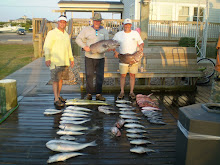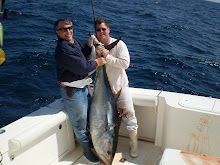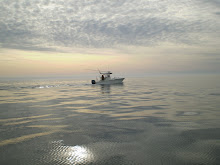
By Jim Field
We watch them from the beach--big slow birds flying in formation like old WWII aircraft--the brown pelican easy to identify and fun to track should they glide past or, spoting bait fish, dive into the water with enough power to make a big entry splash. My two kids could identify them in the air before they were three. In the marina--particularly in Hatteras--the brown pelicans are a constant presence, forever busy, genetically wired to take in the sun and look perpetually for food.
The NYTimes article below is informative and heartbreaking--I had no idea they were one step from being wiped out by DDT in the 1960s, and now face mass slaughter along the Gulf coast as a result of the spill. Bless those working to clean the birds, although, as the article reminds us, only a fraction of pelicans covered in oil will ever be found in time, or at all.
(Accompanying photo)
An oil-soaked brown pelican undergoing treatment at a makeshift bird rehabilitation center in Fort Jackson, La. Many more of the birds were expected.

Pelicans, Back From Brink of Extinction, Face Oil Threat
By JOHN COLLINS RUDOLF and LESLIE KAUFMAN
FORT JACKSON, La. — For more than a decade, the hundreds of brown pelicans that nested among the mangrove shrubs on Queen Bess Island west of here were living proof that a species brought to the edge of extinction could come back and thrive.
The island was one of three sites in Louisiana where the large, long-billed birds were reintroduced after pesticides wiped them out in the state in the 1960s.
But on Thursday, 29 of the birds, their feathers so coated in thick brown sludge that their natural white and gray markings were totally obscured, were airlifted to a bird rehabilitation center in Fort Jackson, the latest victims of the Deepwater Horizon disaster. Another dozen were taken to other rescue centers.
Six more pelicans were brought here on Friday, and as visitors to the center looked on, the birds huddled together in makeshift plywood cages and, in their unnatural stillness, looked as if the gooey muck had frozen them solid. The 29 pelicans brought in Thursday were being treated in hot rooms by workers in protective clothing.
“The pelicans are in dire trouble,” said Doug Inkley, a senior scientist with the National Wildlife Federation, who worried that the oil spill could put an end to the bird’s recovery in Louisiana.
The images of oil-covered birds — pelicans, northern gannets, laughing gulls and others — are eerily reminiscent of the Exxon Valdez disaster 21 years ago, and have in recent days have become the most vivid symbol of the damage wrought by the hundreds of thousands of barrels of crude oil that have poured into the Gulf of Mexico since the Deepwater Horizon rig exploded April 20. Since the spill, 612 damaged birds had been cataloged as of Friday, most dead but some alive and drenched in oil, federal officials said.
Yet the brown pelican, because of its history of robust recovery in the face of extreme peril, has a special significance for the public.
The birds were once so common on the coastline here that they grace the state flag. They were frequent companions for fishermen, who shared their waters and admired their skill at spotting fish from afar and diving from great heights to scoop them up in their bills.
At the turn of the 20th century, observers estimated the brown pelican population in Louisiana at close to 50,000. But by 1961, no nesting pair could be spotted along the state’s entire coast, according to LaCoast, a Coast Guard Web site. Like another subspecies of the brown pelican found in California, the local birds had been hard hit by DDT and other pesticides, which acted to thin the shells of their eggs. The eggs were crushed when the adults sat on them. (DDT was banned in the United States in 1972.)
In 1968, Louisiana took birds from a surviving Florida colony and reintroduced them along the state’s southern coast in three spots. One was Queen Bess Island, which had been the site of one of the last breeding pairs before extinction, said Kerry St. Pé, program director of the nearby Barataria-Terrebonne National Estuary Program.
Still, the birds struggled, threatened this time by the loss of their habitat. The local wetlands, hurt by levees in the Mississippi that blocked sediment from flowing downstream and by canals cut by oil companies looking to lay pipe, were sinking into the gulf at an astonishing rate. Queen Bess was going under as well until 1990, when a coastal restoration project financed a rock barrier around the island, which stabilized it. The pelican colony began to flourish and the birds’ offspring helped repopulate the coastline, Mr. St. Pé said.
Last year, the birds were officially taken off the endangered species list. But the oil spill, experts said, could change that. Like all birds, pelicans are very sensitive to oil, said Melanie Driscoll, director of bird conservation for the National Audubon Society’s Louisiana Coastal Initiative. It prevents them from regulating their body temperature when it gets on their feathers, she said, and in Louisiana the pelicans are subject to overheating. The oil can also poison the fish the pelicans feed on and seep through the shells of pelican eggs, killing the embryos.
The potential for damage was frighteningly apparent at the rescue center set up here by the International Bird Rescue Research Center with BP and federal and state officials. All day Thursday, oiled birds, including the 29 brown pelicans, arrived at the makeshift veterinary emergency room built in a hangar on a former military base. They were carried from Coast Guard helicopters in dog kennels and cardboard boxes with air holes punched in them.
Most of the birds were so thoroughly coated in crude that they could not stand up. Some were stuck to the floor of their cages. Workers wiped off thick globs of oil with towels, then gave them fluids and fed them a fish slurry.
The pelicans were placed in plywood pens covered with blankets. The next morning, workers began to clean them using hot water and Dawn, a mild dish detergent.
So far, even the most heavily oiled pelicans have survived. Had they not been treated immediately, however, they would have almost certainly drowned or died of starvation or exposure, according to a veterinarian with the United States Fish and Wildlife Service.
The birds at the rehabilitation center, said Sharon Taylor, a veterinarian here, represent a lucky few — far more are certain to die in the wild.
“A lot of them will just disappear into the environment,” she said. “We will probably only find a very, very small percentage of what’s been impacted out there.”
Still, she worried that because there are so many large rookeries nearby, far more pelicans would soon be headed to the center.
“Tomorrow or tonight we could get a hundred pelicans, we could get a thousand pelicans,” Ms. Taylor said.









No comments:
Post a Comment